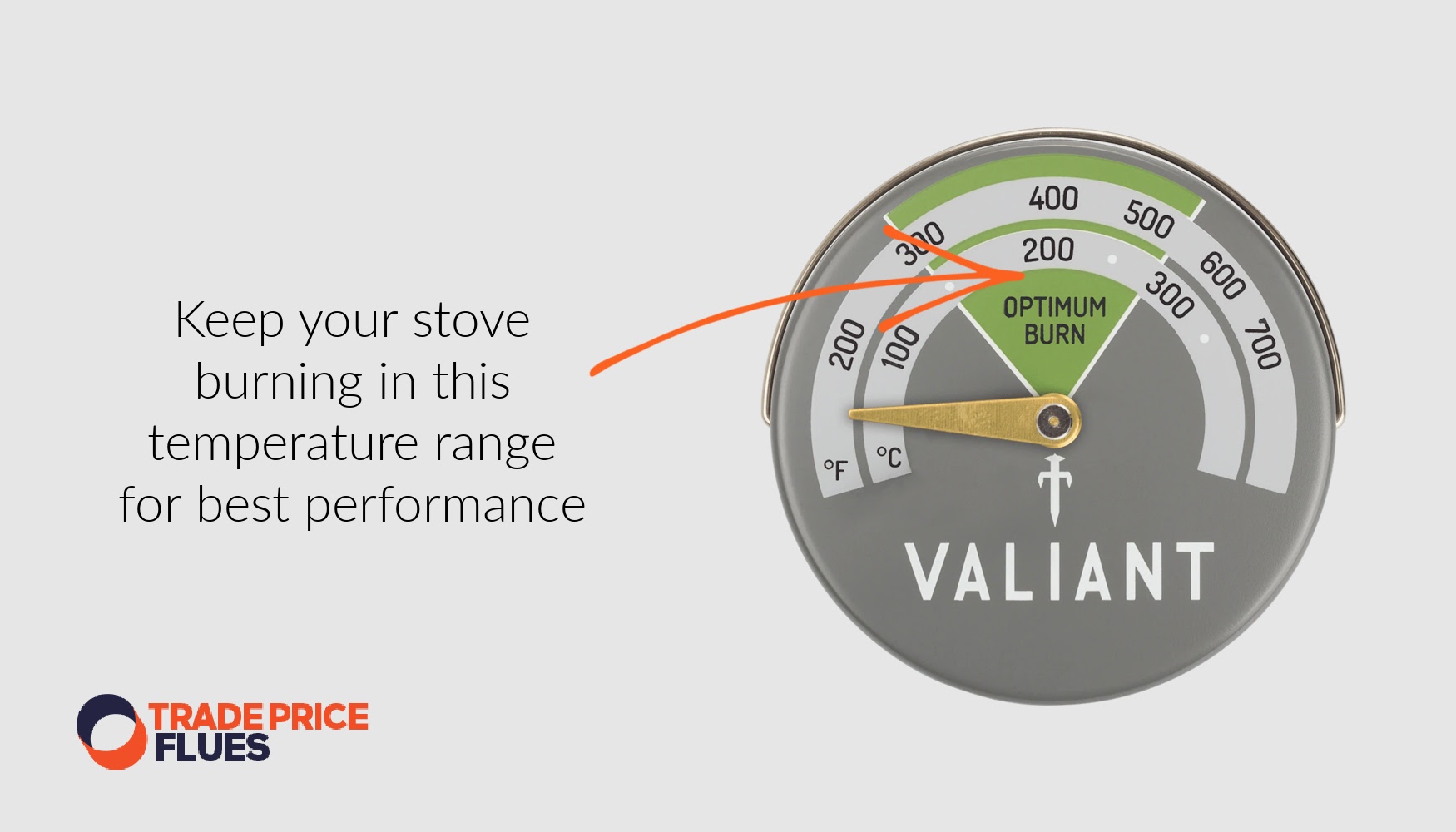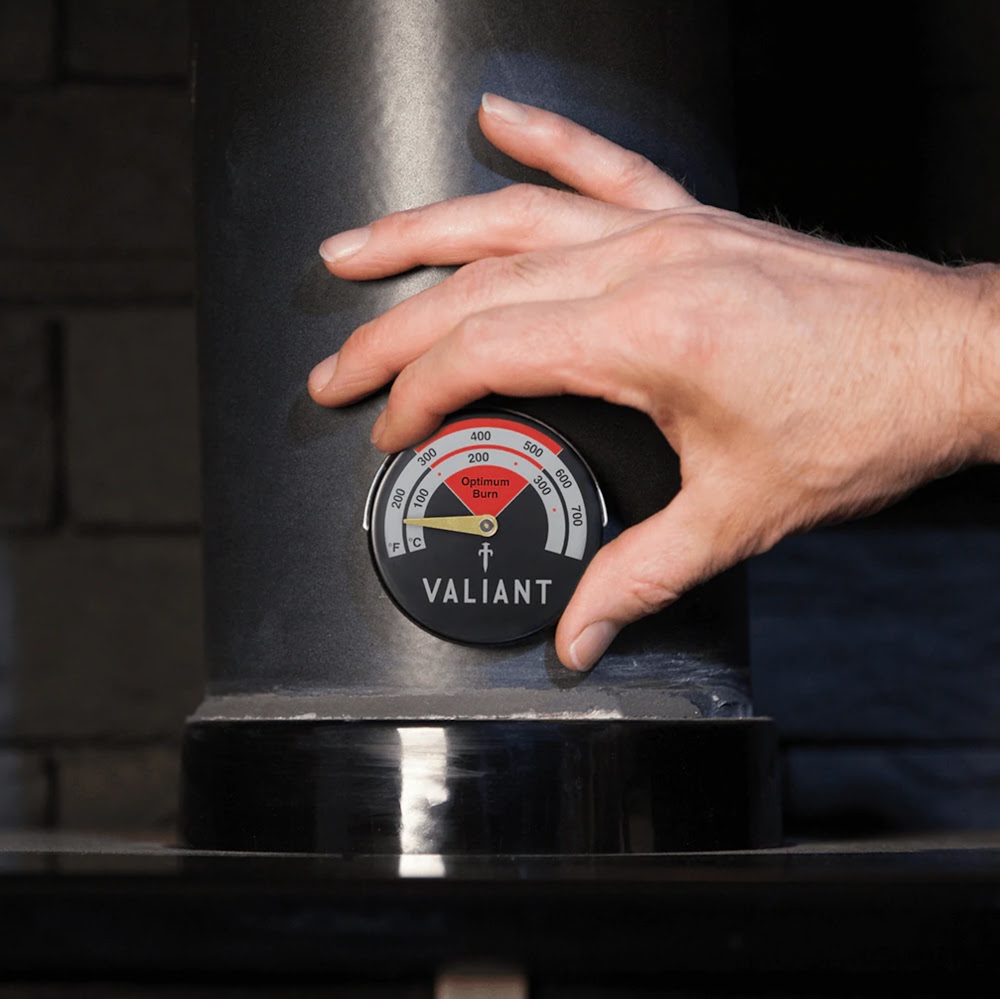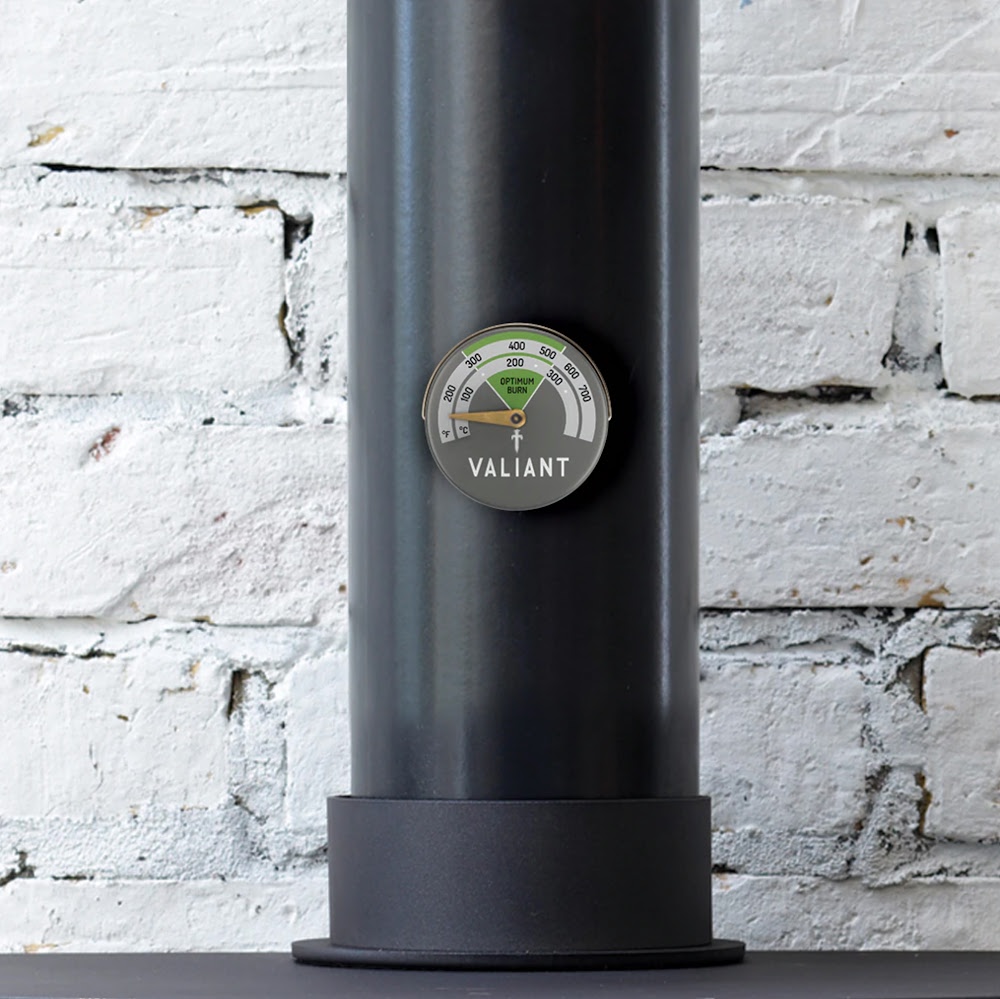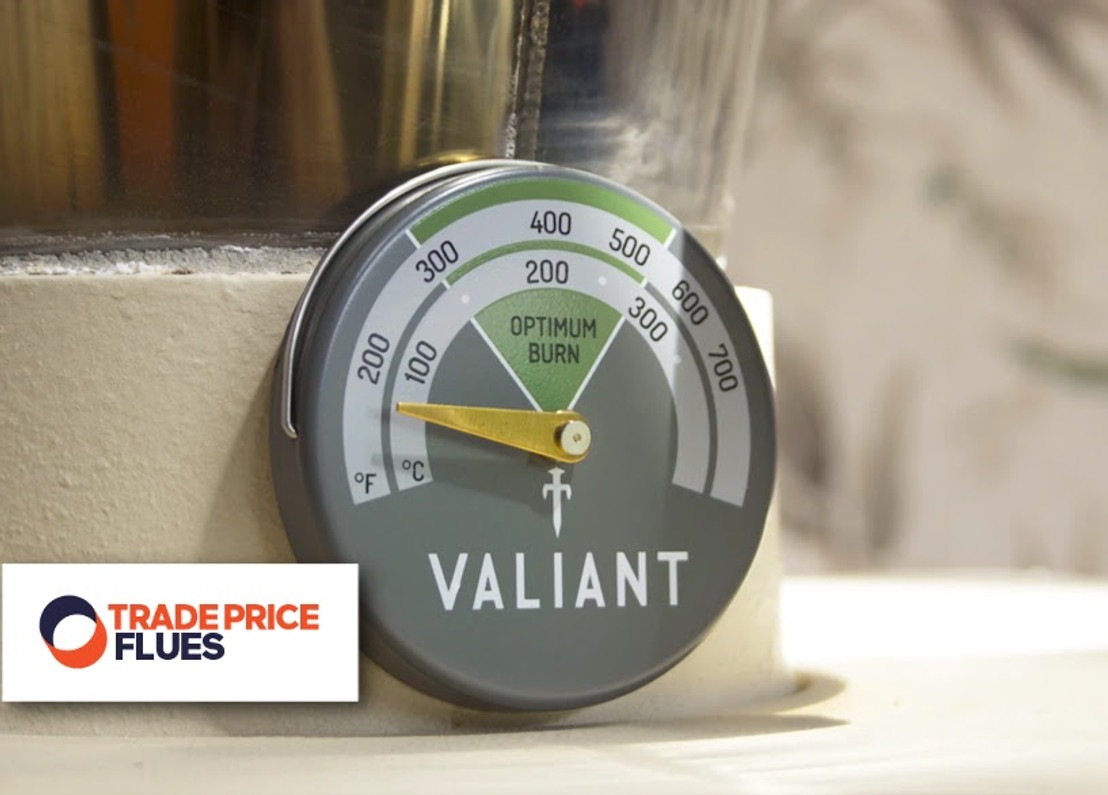How Do You Use a Flue Thermometer?
How do you control the temperature that’s being generated by your log burner? That’s a question we receive regularly here at Trade Price Flues. The answer is to use a flue thermometer. But the key is to use one properly. If you’d like to know how, then keep on reading…
Flue thermometer definition
Ask many people to think of a thermometer and they’ll probably conjure up images of those old-school glass thermometers that you pop in your mouth when you’re feeling under the weather.
Flue thermometers are something quite different.
A flue thermometer can be defined as a non-electric thermometer which is designed to be magnetically attached to the flue pipe of your log burner. The thermometer will provide an accurate reading of the temperature that the stove is currently burning at.
Good quality flue thermometers will feature a scale with an indicator which shows the optimum burning range:

With this temperature information, you can decide whether you need to add further fuel to your log burner, or to close the air vents and dampen the fire down so it isn’t burning as fiercely.
Why do you need a flue thermometer?
Do you really need a flue thermometer? We’d say yes.
Unlike other heating appliances, log burners don’t have any way of telling the temperature that they are operating at.
Flue thermometers rectify this, providing you with an easy ‘at a glance’ view of what temperature your log burner is burning at.
The benefits of using a flue thermometer
Aside from providing you with the operating temperature of your log burner, there are a number of other benefits that come with using a flue thermometer.
Prevents overfiring
A flue thermometer is one of the best ways of preventing overfiring.
Overfiring refers to the situation where the fire in your log burner becomes hotter than your log burner was designed for.
For example, your log burner may have a stated heat output of 5kW.
But if you overfire it, by adding too much firewood to it and allowing too much oxygen to reach the heart of the fire, then the temperature of the fire can go above 5kW, and thus cause damage to your log burner.
This damage can be permanent, including the warping and/or cracking of the firebox, the failure of seals and other types of damage.
By using a flue thermometer, you can keep your log burner’s fire burning within its safe operating temperature.
Protects your chimney
Related to the point of overfiring, is the issue of chimney damage.
If you regularly let your log burner run too hot, then you run the risk of causing damage to your chimney.
This damage can include cracks within the chimney’s clay lining, or even structural damage to the brickwork itself.
By using a flue thermometer, you’ll be able to keep your log burner running at a suitable temperature that won’t cause damage to your chimney.
Reduces creosote buildup
Just as running the fire in your stove too hot can cause damage, running the fire at a low level can cause creosote to build up.
This is because, if the fire is only burning at a low level, it won’t be burning off all of the combustibles from the firewood. This creates creosote which is a fire hazard.
A flue thermometer will help you spot when your log burner’s fire isn’t burning hot enough, so you’ll know that you need to add more fuel.
Reduces fuel usage
With the exact knowledge of what temperature your log burner is running at, you’ll be able to make the most efficient use of your firewood.
Without a thermometer, it’s easy to overfeed a fire and throw on logs when they’re not really needed.
By keeping the log burner within the ‘optimum burning range’ on the thermometer, you’ll be ensuring that your fire is burning as efficiently as possible.
Not only does this have the benefit of reducing your fuel usage, but it also means that your log burner will be burning at its ‘cleanest’, burning up the combustibles and particulate matter from the firewood. This is far better for the environment than letting your fire under or over burn.
Minimises log burner cleaning
By using a flue thermometer to keep your log burner running at its optimal operating temperature, you’ll end up with less cleaning to do.
This is because your stove won’t be producing the creosote that it would be if it was running at a less than optimal temperature.
With an efficiently burning fire, as much of the combustible material as possible will be burned away, leaving you with only ashes to clear away once you’ve finished your fire.
Where to position a flue thermometer
As you can see, there are certainly plenty of benefits to using a flue thermometer. And, given that they only cost £10-15 there isn’t really any reason why you shouldn’t buy one!
If you do buy one, then it’s important that you position it in the correct place on your log burner.
Get the positioning wrong and you won’t get an accurate reading of the log burner’s temperature.
The best place to position a flue thermometer is, as its name suggests, on the flue pipe just above where it exits the main body of the log burner, as pictured below:

Here at Trade Price Flues, the thermometers that we stock are manufactured by Valiant, who recommend this placement.
If it’s not practical to place the thermometer in this location, then try to place it somewhere that is as close as possible to the flue pipe, such as on the top of the body of the log burner.
We know that other manufacturers recommend different placements for their own thermometers.
So, if you’re in doubt about the correct placement of your flue thermometer, then always refer to the manufacturer’s recommendations.
Note - quality thermometers, such as the ones stocked here at Trade Price Flues, should attach to the flue pipe using a strong magnet. Do not attempt to drill or fix your thermometer in place as this can cause damage and impair the function of your log burner.
How to use a flue thermometer
There are three main ways to use a flue thermometer:
- To tell if the temperature of your log burner is too low.
- To tell if the temperature of your log burner is within the optimal range.
- To tell if the temperature of your log burner is too high.
As you’ve probably already guessed, you want to make sure that your log burner is always burning within the optimal temperature range.
Within this range, the fire in your log burner will be burning at its most efficient, secondary combustion will be occurring (so all of those combustibles and particulates will be getting burned up), and there will be little to no smoke.
Why is my log burner temperature too low?
If your thermometer is indicating that your log burner’s fire isn’t burning hot enough, it’s likely down to one (or more) of the following reasons:
> You are using firewood which isn’t properly seasoned.
> There isn’t enough oxygen reaching the heart of your log burner’s firebox.
> You aren’t using enough firewood, or you need to top up your fire with more firewood.
To remedy these things, make sure you’re using properly seasoned, dry, firewood, try opening up the vents on your log burner and try adding more (but not too much) firewood to the fire.
Why is my log burner temperature too high?
Should your thermometer by indicating that the temperature of your log burner fire is too high, it could be because of the following things:
> You are using too much firewood in your stove.
> The log burner’s vents are open too wide.
You can tackle this by closing the log burner’s vents slightly, and allowing the fire to die down. Make sure you don’t add any additional firewood until the temperature is within the lower part of the optimal range on the thermometer.
What to look for in a flue thermometer
So, what features should you look for in a flue thermometer? In order to buy a thermometer that works well for you, you should look for the following features:
> A strong magnet so that it can securely attach to your log burner’s flue pipe.
> A clear indicator, with a highlighted section to show the optimum temperature range.
> Should be suitable for use with vitreous enamel, iron or steel flue pipes.
Find a flue thermometer with all of those features and you should snap it up!
Best flue thermometer UK
So, with all of the above in mind, you might be ready to buy a thermometer for a log burner. If that’s the case, then check out the thermometer below that ticks all of the boxes that we’ve described above.
Valiant Flue Thermometer

Shop Now - Valiant Thermometer
The Valiant flue thermometer clearly displays the temperature of your stove, with a clearly marked optimum burning range.
Thanks to its robust design and strong magnet, it’ll provide you with years of reliable service. The magnet is strong to the point that it’ll maintain its hold on metal up to a temperature of 800ºF (425ºC).
It will adhere to a range of surfaces including vitreous enamel, iron and steel. It’s also suitable for use with a range of appliances beyond log burners, such as BBQs, range cookers, patio heaters, chimineas and general flue pipes.
Pick up your essential log burner accessories today
You’ll find a wide range of log burner essentials in stock here at Trade Price Flues. From thermometers to stove fans, air vents to fire cement, we’ve got everything you need to keep your log burner running in top shape.
Shop log burner accessories at Trade Price Flues now
For more log burner advice, information and buying guides, read the Trade Price Flues blog…
Do You Need a Chimney Cowl on Your Chimney? | How to Make Your Wood Burning Stove More Efficient | A Complete Guide to Log Burner Flues
Latest Articles
-
Air Pollution Down in the UK Despite Record Wood Burner Sales
Great news! Wood-burning stoves, once considered environmental villains, have transformed into eco-f …18th Apr 2024 -
A Guide to Stove Installation in Lodges, Sheds, and Shepherd’s Huts
Shepherd’s huts, lodges, and sheds have become increasingly popular as charming retreats or alternat …25th Mar 2024 -
Pinned vs. Pinless Moisture Meters: Which is Best for Firewood?
When you collect or buy firewood, it usually starts very moist inside. Using sopping wet wood to bur …4th Mar 2024






